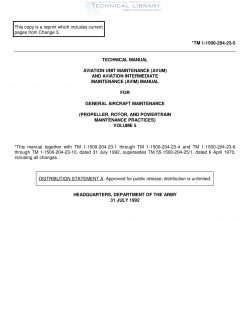ARMY-TM-1-1500-204-23-5
- Version
- 234 Downloads
- 1.02 MB File Size
- 1 File Count
- March 5, 2017 Create Date
- March 5, 2017 Last Updated
Propeller, Rotor, and Powertrain Maintenance Practices - Vol. 5

1-1 Purpose. This volume provides general informa- tion pertaining to aircraft propeller, rotor, and powertrain maintenance practices and procedures. The application of materials and techniques used on specific aircraft is not covered in this volume. Specific aircraft application, usage, and substitution are found in the individual aircraft maintenance manuals. This volume is of maximum benefit to the mechanic who desires information about propellers, rotors, and powertrains. This volume fur- nishes the mechanic a source of information about how to perform various mechanical functions which are used on all aircraft. This volume is not a requisitioning author- ity, and applicable repair parts and special tools list should be consulted to obtain the unit of issue and Na- tional Stock Number of the items required for mainte- nance. 1-2 Scope. General information to guide aircraft main- tenance personnel is covered within this volume; howev- er, no attempt has been made to include special parts or equipment which are applicable only to individual or spe- cific aircraft. Propeller maintenance practices and proce- dures are covered in Chapter NO TAG. Rotor mainte- nance practices and procedures are discussed in Chapter NO TAG. Powertrain maintenance practices and procedures are presented in Chapter NO TAG.
1-3 Consumable Materials. 1-4 Principles of Helicopter Flight. Basic flight theory and aerodynamics are considered in full detail when an aircraft is designed. The rotor repairer must understand these principles in order to maintain aircraft safely and to make repairs that are structurally sound and aerodynamically smooth. a. Aerodynamics. Aerodynamics deals with the motion of air and with the forces acting on objects moving through air or remaining stationary in a current of air. The same principles of aerodynamics apply to both rotary- wing and fixed-wing aircraft. Four forces that affect an aircraft at all times are weight, lift, thrust, and drag: D Weight is the force exerted on an aircraft by gravity. The pull of gravity acts through the air- craft's center of gravity, which is the point at which an aircraft would balance if suspended. The magnitude of this force changes only with a change in aircraft weight. D Lift is produced by air passing over the wing an airplane or over the rotor blades of a helicopter.
| File | Action |
|---|---|
| ARMY-TM-1-1500-204-23-5 Propeller, Rotor, and Powertrain Maintenance Practices - Vol. 5.pdf | Download |

Comment On This Post